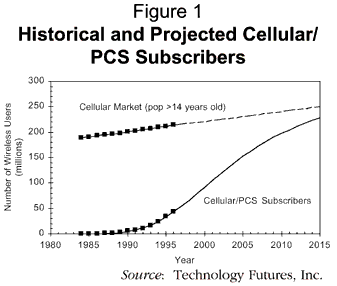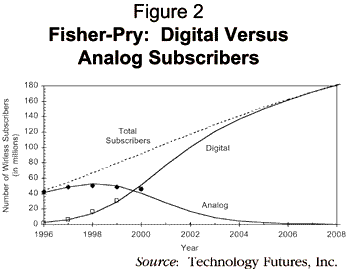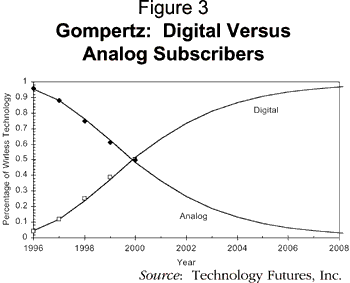
A second generation of digital technology is now being implemented, which offers users more features at a lower cost. This raises the issue of how much longer the existing analog system can remain competitive. There are two primary market forces, which will ultimately determine the timing and demise of analog cellular:
Digital wireless technology is just now entering this final stage as cellular providers begin to replace some of their legacy analog systems. To date, they are primarily replacing some analog channels with digital at each cell site to gain additional capacity. For some time, at least, both technologies will be necessary to provide blanket geographical coverage for both existing analog cell users and newer digital service subscribers so as to avoid creating gaps in coverage. However, as cellular providers begin to replace their analog equipment with digital systems and subscribers transition their services from analog to digital, the dual mode system will no longer be required. The focus of this article is to present TFI's latest forecasts for the:
Our current forecast for wireless subscribers in the United States is based on trending an adoption pattern using 13 years of historical data. We assume the total U.S. wireless subscriber market consists of persons 15 years and older, which equals 80% of the total U.S. population. Aware that both cellular and PCS satisfy some of the same needs for personal communications services, our market growth forecasts for total wireless subscribers includes both analog and digital subscribers. If cellular adoption to date represents subscribers' preferences for mobility and portability, then its historical growth pattern should be a good indicator of the future wireless market. TFI's projections to 2015 for total cellular/PCS subscribers are presented in Table 1 and shown graphically in Figure 1.
| Table 1 Historical and Projected Cellular / PCS Subscribers | ||
| Year | Market (Population > 14) | Cellular / PCS Subscribers |
| 1992 1993 1994 1995 1996 1997 1998 1999 2000 2001 2002 2003 2004 2005 2006 2007 2008 2009 2010 2011 2012 2013 2014 2015 | 205 207 210 212 214 216 217 219 221 223 225 227 229 231 233 235 236 238 240 242 244 246 248 250 | 11 17 24 33 43 55 67 79 92 105 117 130 141 152 163 172 181 190 197 205 211 217 223 228 |
| Source: Technology Futures, Inc. | ||

There are currently about 55 million wireless subscribers in the United States, and we project that number will increase to nearly 200 million by 2010. This implies that, by 2007, there will be as many wireless subscribers as there are wireline subscribers today.
Several research firms have done short-term market forecasts of individual digital technologies, including CDMA, TDMA, and GSM, which are reasonably consistent. We used Strategies Group's projections through 2000 to provide four near-term data points, which enabled us to compute a rate for our substitution analysis.2 We treated all the digital wireless technologies as one single digital technology substituting for analog. There is, however, always the potential for one technology to dominate and displace the other digital technologies.
TFI chose to evaluate each of the scenarios described above using two different substitution models.3 This allows us to forecast a range rather than a single data point. As can be seen in Figures 2 and 3, we expect digital to replace analog within eight to 12 years. In the scenario for Figure 2, the network operators, opting to cut costs and phase out the older technology as quickly as possible, push the newer digital technology into the marketplace with pricing and promotional incentives. In this situation, we project digital to fully replace analog within eight years.


In Figure 3, consumers pull the technology into the marketplace at their own rate of adoption. In this situation, we project it will take up to 12 years for all subscribers to abandon the analog network. We believe that the most likely scenario, however, is somewhere in between, with network operators pushing consumers to abandon the analog cellular network within 10 years.
Perhaps more important than the data points given above, however, are our projections that over 50% of all wireless subscribers will be using digital technologies by 2000. Furthermore, we project that number will grow to approximately 90% by 2005. These forecasts imply the average remaining life of analog investment is only 2.5 years to 3.6 years.
Clearly, multiple-access digital systems are superior to single access analog systems and will displace them. What remains unclear is whether the final replacement of analog with digital will be forced by the network operators or driven by consumer adoption. In either case, the substitution is underway and should be completed in the 2006 to 2010 timeframe.